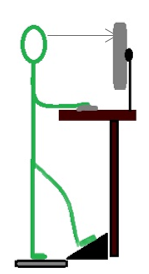 Changing to standing desks – Is this the answer to all of our sedentary life and back problems?
Changing to standing desks – Is this the answer to all of our sedentary life and back problems?
Did you know that in the UK alone, back issues account for over £1.5B in sick leave every year?
Dr James Levine, director of the Mayo Clinic State University Obesity Solution Initiative and inventor of the treadmill desk believes that “Sitting is the new smoking”. Research has directly linked prolonged sitting due to sedentary life with serious illnesses as such as cancer, heart disease and type 2 diabetes.
Any type of static posture maintained for a prolonged period of time is harmful to the body, putting loads on the muscles and tendons and ultimately reducing the blood flow, causing damage.
6 TIPS IF YOU CONSIDER WORKING ON A STANDING DESK
1. Think first
Analyse your work activity. Do you currently sit at a desk all day? Are your daily tasks repetitive? Do you have to focus for prolonged period of time? Are you under time pressure? Would a standing desk allow you to be more productive in your work activities? Maybe, or Maybe not. A standing desk is only equipment/furniture, YOU will remain in charge of adapting your behaviour towards the organisation of your daily work and the way your lead your life (sedentary or more active).
2. Decide which desk to get
The market is flooded with different desk options – Stand only, Flexible sit-stand desks, or even adjustable platforms that are placed on top of the desk and can be adjusted up and down to suit standing and sitting postures. Will your body be able to stand for a full day at a desk? Of course, a quiet, high quality standing desk which is easily adjustable in height would be the best but those desks are usually expensive. So, if you compromise due to the budget, floor space or other reasons, ensure that the standing desk will fit your body and still allow a suitable posture. At the end of the day, you might have to add equipment such as monitor riser, sit-stand chair, or even a mat in order to really improve your health, productivity, and posture.
3. Once your desk arrives – ensure it is adjusted correctly!
HEIGHT OF THE DESK/ KEYBOARD: Elbows’ height. Back straight (neutral posture not bent)
- TYPING POSTURE: – wrist straight, neutral posture. (avoid leaning on the desk or over-reaching for typing) Shoulder relaxed and elbows at the same height as the top of the desk/surface (forearm-wrist straight and supported).
- MONITOR’s height: Head/neck straight –eyeline in the top third of the screen. The menu bar of your window in full screen should be in your eye-line without having to bend your neck or look up to it.
- Set-up of equipment: Every item on the desk that you are using the most should be at elbows range.
4. Mind your legs!
Prolonged Standing puts greater strain on the circulatory system and on the legs and feet. This increases the risks of varicose veins. Stand on an adequate surface to maintain good blood flow. Use an anti-fatigue mat or a footrest for lifting one foot at the time.
5. Are you taking regular micro-breaks?
As with sitting on a chair, a static standing posture is not advised to be kept for a prolonged period of time. Every 30 minutes release the pressure put on the static part of your body by moving/stretching gently for few seconds and repositioning yourself in the recommended posture. For example, if you were typing on the keyboard for the past 30 minutes, roll gently and slowly back the shoulders, move your fingers and drop your arm along your body for a few seconds. Then start typing again. If you are standing up all day, consider to having some sitting time (morning break, lunchtime..) for a few minutes every hours.
6. Listen to your body. Always!
The use of a standing desk is not recommended if you are already experiencing a discomfort, especially on the upper back and shoulder, as it could make the condition worse. Having the desk not adjusted at the recommended height can result in pain and injury. Do not ignore the first sign of discomfort.
Adjust your lifestyle. If you spend the majority of your day moving, walking, consider resting your body more after work.
An Ergonomic expert’s opinion – The bottom line:
Simply standing is not sufficient. Movement is important to get blood circulation through the muscles. The body is made to move.
Before getting a new desk, start to change your work habit. Include micro-breaks during your day. Research shows that you don’t need to do intense exercise to get the benefits, merely walking around is sufficient. Therefore, build in pattern of creating greater movement variety in the workplace (e.g. walk to a printer, water fountain, stand for a meeting, take the stairs, park a bit further away from the building each day, walk ).
Aim for variety in your posture, work activities. Sit for computer work. Sit using a height adjustable desk or platform that allows a good posture. Stand-up every hour for 10 minutes and move for 5 minutes looking away from the screen.
If you are contemplating changing office furniture at your company or require assistance in adjusting your desk, analysing your work activities to make you more productive and reduce the risk of developing repetitive strain injury please contact one of the Chris Mee Groups Ergonomic Specialists. Stay tuned for further tips and examples in the next article.

